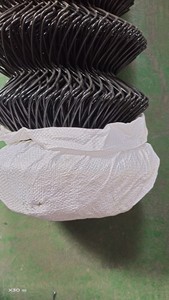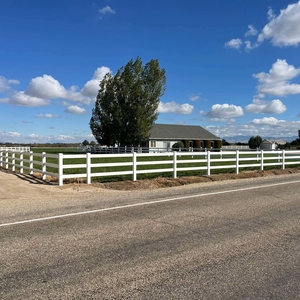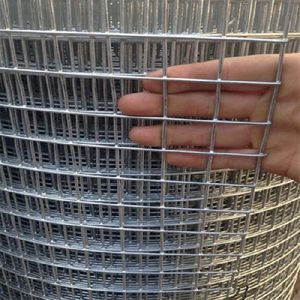(557 products available)






























































































































































































A 5x5 mesh fence is a type of fencing material commonly used for various applications. It is made from interwoven wires that form a square pattern, with each square measuring five inches by five inches. The mesh can be made from different materials, including galvanized steel, stainless steel, or coated wire, offering durability and strength. The woven design provides visibility and ventilation while ensuring security and containment. Here are some types of fence mesh:
Welded wire fence mesh
This is made by welding the wires at their intersections using electric currents. The welds are strong, and the mesh has a uniform pattern. It is often coated with galvanized zinc for rust resistance.
Knotted wire fence mesh
This has a more flexible construction than the welded type. Each joint is tied into a knot, making it stronger and able to withstand impacts without deforming.
Expanded metal mesh
This is created by cutting and stretching a solid metal sheet into a diamond-shaped mesh pattern. It is rigid and offers excellent security for doors, windows, and screens.
Chain link fence mesh
Also known as diamond mesh, this is made from galvanized or coated steel wire. The wires are woven into a diamond pattern. It is economical and provides good security for areas like playgrounds, parks, and industrial sites.
Hexagonal wire mesh
This is often used for chicken coops, rabbit pens, and other small animal enclosures. It has a hexagonal shape, which prevents animals from pushing through the mesh.
Electric fence mesh
This incorporates an electric fencing system into the mesh. It delivers an electric shock to animals or intruders when they touch the mesh, helping to secure farms and wildlife areas.
Material Options:
The 5x5 mesh screens are made from various materials to suit different needs. Galvanized steel is a popular choice for its strength and rust protection. Stainless steel offers even better protection against rust and corrosion, making it suitable for use in harsh environments. Vinyl-coated wire mesh provides a colorful and protective coating for the mesh, while welded wire fabric gives a smooth and sturdy surface. Each material is chosen based on where the mesh will be used and what it needs to withstand.
Weave Patterns:
Fence mesh design includes different weaving methods for the wires. The square mesh has a simple crisscross pattern, while diamond mesh looks like overlapping diamonds. These weaves make the mesh strong and flexible for various uses. The choice of weave affects the look and how well the mesh works in different situations.
Coatings and Finishes:
5x5 fence mesh can have different coatings and finishes to protect it and improve its appearance. Galvanized steel mesh is coated with zinc to prevent rusting. Stainless steel mesh does not need much finishing because it is corrosion-resistant. Vinyl coating provides color and protection for the mesh and welded wire fabric coatings give it extra durability.
Frame and Support Structures:
The frame and support for the 5x5 mesh are important for its strength. Heavy posts and rails are used for the frame, and cross-bracing makes it even stiffer. Gates need to be as strong as the panels, so they are reinforced. The design ensures that the mesh screen can withstand pressure and last a long time.
Customizations:
5x5 fence mesh can be made to order for special needs. The mesh can be cut to fit any shape or size required. Different materials can be used as needed, and the spacing between the wires can be adjusted. Custom colors and coatings are also available to match specific designs. These customizations allow the fence mesh to be used in places where standard sizes do not work, without sacrificing strength or look.
Construction Sites:
5x5 fence mesh is used to secure construction sites. The mesh keeps large objects and machinery inside and prevents them from leaving the site. It also helps to keep people out of dangerous areas.
Agriculture and Farming:
Farmers use 5x5 fences to make animal pens. The fences keep animals safe and contain them in one area. The mesh is also used to protect plants from animals and to support climbing plants.
Road and Highway Projects:
Fence mesh is used on road projects. The mesh fences keep work areas safe and reduce accidents. They also block debris from leaving the site and causing accidents.
Mining Operations:
In mining, mesh fences control where people can go. The fences protect dangerous areas and help prevent accidents. They also keep wildlife away from mining areas.
Sports Facilities:
Mesh fences are installed around sports fields and courts. The fences keep balls and equipment inside the playing area and spectators safe. They also protect the field from animals and damage.
Residential Landscaping:
In backyards, 5x5 fence mesh is used for many things. It makes gardens look nice and keeps plants in. The mesh can also support trellises or screens for privacy. It keeps animals out of the garden and can even act as a pool safety barrier.
From a practical point of view, choosing the right fence mesh involves considering many factors. These factors are the material, mesh size, wire gauge, purpose, location, climate, and budget.
Material
All fence mesh materials have pros and cons. Galvanized steel provides strength and rust resistance. Vinyl-coated welded wire offers color options and protection. Stainless steel mesh provides durability and corrosion resistance. Choose the material that will meet the needs and budget for the fence.
Mesh size
The size of the mesh and the spacing between the wires affect the fence's visibility and its ability to contain or exclude animals. Smaller mesh sizes are suitable for smaller animals and provide more security. Larger mesh may be appropriate for larger animals or when visibility is a concern. Select a mesh size that will suit its purpose.
Wire gauge
The wire gauge indicates the thickness of the wire used in the mesh. A lower number usually means a thicker wire. A thicker wire can make the fence more durable and can withstand more damage. However, it is also more expensive. Find a balance between cost and durability for the wire gauge.
Purpose
Clearly define the purpose of the fence. Is it for containing livestock, protecting gardens, creating security enclosures, or erosion control? The purpose will determine the type of mesh and its design features. For example, a livestock fence needs to be strong and durable. A decorative garden fence can use a finer mesh and have more design.
Location
Consider the location of the fence and any specific requirements. Will it be installed in a rural or urban area? Will it be exposed to any special conditions, such as saltwater or chemicals? These factors may require additional features, such as corrosion protection or special coatings.
Climate
The climate can affect the fence mesh's performance and lifespan. In coastal areas with saltwater exposure, choose meshes with corrosion-resistant coatings. In areas with extreme temperatures, ensure the mesh can withstand the temperature variations.
Budget
Finally, consider the budget for the project. More expensive fence meshes may have special coatings that extend their life or provide unique features. Ensure the mesh fits the budget but also consider the long-term costs of maintenance and replacement.
Q1: How can one install a 5x5 mesh fence?
A1: The installation process may differ depending on the type of mesh fence. For chain link fence, users need to prepare the posts, attach the mesh, secure the tension, and add the finishing touches. For welded wire fence, they need to set the posts, unroll the mesh, attach it to the posts, and trim the excess.
Q2: What are the uses of a 5x5 mesh fence?
A2: A 5x5 mesh fence can be used for different applications, such as construction site safety, agricultural containment, animal control, security, and scaffolding.
Q3: How long does a 5x5 mesh fence last?
A3: The lifespan of a mesh fence can vary depending on the material, maintenance, and environmental conditions. For example, vinyl-coated chain link fences can last for 20 years or more, while galvanized mesh may have a shorter lifespan of 10 to 15 years.
Q4: What is the difference between a 5x5 mesh fence and a chain link fence?
A4: The 5x5 mesh refers to the size and shape of the openings in the mesh material, while the chain link refers to the weaving technique used to create the mesh. Both fences are different in terms of design and application.
Q5: How can one maintain a 5x5 mesh fence?
A5: To maintain a mesh fence, regularly inspect it for damage, clean it to remove dirt and debris, and apply protective coatings to prevent rust or corrosion.